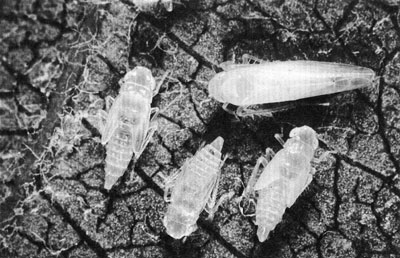 |
| These apple leafhopper nymphs and adult show the shape of the insect. Potato leafhoppers are the same shape but greenish in color. Photo courtesy of Don Barry, Univ. of Maine Pest Management Office. |
By Eric Sideman, Ph.D.
MOFGA’s Director of Technical Services
Last year towards the end of June and early July, I started to notice brown areas at the tips of the leaflets of my potato plants. The browning spread backwards and inwards from the margin and eventually the whole leaflet was destroyed. This was not the first time I had seen this type of injury: In years past I would see this and by early August I would have no potato plants left. This was, however, the most widespread injury I had ever seen so early in the season. My bean plants, too, were greatly stunted and the leaves were yellow and curled.
Thanks to Ed Plissy (Maine’s retired potato specialist), I knew what to look for. Years ago when I got tired of having no potato plant tops to kill in the fall before digging tubers, I went to Orono to talk to Ed. Of course, we could only talk hypothetically because I had no plants to show him. I kept trying to lead him toward disease problems. Could it be late blight? Potato early dying syndrome? Actually, Ed said, it was more likely to be leafhopper burn. The insect is tiny and the early symptoms are subtle, so many folks don’t notice the problem – until it’s too late. Then, in August, the plants go down like rocks.
He was right. I’d witnessed that scenario before, so this year when I saw the subtly curled leaflets and pale veins – and stunted bean plants with yellowed, curled leaves – I recognized the problem. I lightly brushed the tops of the plants, and sure enough, little flecks started to flicker through the air. I carefully turned over some leaves and looked. There they were. Potato leafhoppers.
Leafhoppers are wedge-shaped insects that are broad in the head to thorax region and taper towards the back. There are many kinds of leafhoppers, but the one of great concern to bean and potato growers is the potato leafhopper. It is vivid lime green to pale green with variable white markings on its head. It is very small, only about 3 millimeters long. The bugs are very active and jump or fly on the slightest disturbance, so the best way to see if you have them is to rub your hand along the plant tops and look for the flight. If you scare up a cloud, you are in trouble. A very few leafhoppers can cause economic loss for a commercial grower.
Leafhoppers feed by sucking juices out of the plant – specifically out of the phloem cells, which conduct food from the photosynthesizing leaf to the other parts of the plant. When they feed they inject a toxin that swells the cells and cuts off the flow off food.
Potato leafhoppers pass through three life stages: egg, nymph and adult. They do not overwinter near here and have not been found overwintering north of the Gulf states, such as Louisiana, where they breed year round. In the spring, they migrate north with warm winds. They probably arrive in Maine in late May to early June, and symptoms of their feeding can be seen by the trained eye in June. Leafhoppers go through two to four generations in Maine before they die in the winter. The nymphs are even smaller than the adults when young, but do as much feeding and damage. Pick a bunch of leaves and look carefully at the underside for feeding nymphs.
Since they do not overwinter near your garden or fields, potato leafhoppers cannot be controlled by crop rotation. In most years insects are not numerous and you can just tolerate some loss, but in other years, as in 1997, the damage is devastating. You cannot know in advance how a particular year will be. Please call me as soon as you see any symptoms and I’ll spread the word.
The only organic control that I saw working last year was spraying with pyrethrum. Since leafhoppers are sucking rather than chewing feeders, rotenone is not effective. Formulations of pyrethrum that contain piperonyl butoxide (PBO) are much more effective. (NOTE: Although PBO is derived from a plant source originally, it undergoes a substantial molecular change in its extraction and processing. Thus, it is considered a synthetic material and not permitted by many organic certifiers. MOFGA permits PBO as a synergist because of its ability to make botanicals much more effective and hence greatly reduce the number of sprays required per season.) You can also use row covers to exclude leafhoppers, but must get them on early in the season.
Although textbooks say that potato varieties do not differ in resistance to leafhoppers, some growers told me that they had noticed great differences among varieties. I do not have enough information now to report, but I would like to hear from anyone who notes such differences. r
About the author: Eric is MOFGA’s “extension agent”and can be reached at the MOFGA office to answer your questions about farming and gardening.
